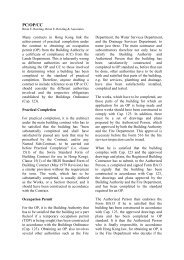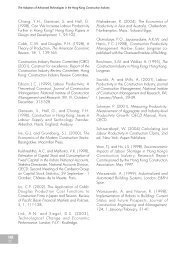Surveying & Built Environment Vol. 22 Issue 1 (December 2012)
Surveying & Built Environment Vol. 22 Issue 1 (December 2012)
Surveying & Built Environment Vol. 22 Issue 1 (December 2012)
Create successful ePaper yourself
Turn your PDF publications into a flip-book with our unique Google optimized e-Paper software.
SBE<br />
<strong>22</strong><br />
Reconstructing The Early History of the Gin Drinker’s Line from Archival Sources<br />
a series of temporary redoubts at<br />
the beginning of any hostilities with<br />
France and Russia along a 15-km front<br />
stretching from near Devil’s Peak to<br />
Lai Chi Kok Pass, with Chiu Lan Chu,<br />
Grasscutters Pass, Beacon Hill Pass<br />
and Kowloon Reservoir in between.<br />
This should be the official basis for the<br />
mainland defence line which Anderson<br />
formally proposed to the War Office to<br />
construct in May 1911. 9<br />
Anderson’s idea was not considered<br />
until he argued that the rapidlymodernising<br />
Chinese army might be<br />
able to threaten the safety of Hong<br />
Kong in early 1912. In particular, he<br />
mentioned the effectiveness of the<br />
Cantonese New Army (xinjun), which<br />
had participated in the Revolution. 10<br />
Paradoxically, the formation of a<br />
republic in China raised rather than<br />
eased British concern for the security<br />
of Hong Kong. Although the Overseas<br />
Defence Committee acknowledged the<br />
need to build an “infantry defence line,”<br />
it did not specify its scale or budget.<br />
After that, the War Office sanctioned<br />
Anderson to build redoubts armed with<br />
heavy guns along the Kowloon Ridge. 11<br />
However, the First World War broke out<br />
before any actual work had been done.<br />
During the First World War, a smaller<br />
defence line was built across the<br />
Kowloon Peninsula near modernday<br />
Ho Man Tin and Yau Ma Tei.<br />
“Caponiers” (the term used in official<br />
documents) were also built near major<br />
batteries such as the Lyemun Battery,<br />
Devil’s Peak and Mount Davis. 12<br />
Although actual maps have yet to<br />
be found, it was noted that the line<br />
consisted of trenches and pillboxes<br />
built with plywood and corrugated<br />
metal, protected with barbed wire.<br />
Nonetheless, as the Hong Kong<br />
Government started to develop the<br />
nearby area, the garrison reported some<br />
of the recent building works had already<br />
overlapped with the defence line. 13 In<br />
January 1915, the Commanding Officer<br />
of the Royal Engineers at Hong Kong<br />
suggested that the British might have<br />
to defend a new position along the<br />
Kowloon Ridge as the result of urban<br />
expansion. 14<br />
After the First World War, the question<br />
of Hong Kong defence resurfaced as<br />
Japan was seen as a potential foe. Hong<br />
Kong was seen as an important base in<br />
the Royal Navy’s plan against Japan<br />
(the War Memorandum (Eastern)) as it<br />
was closest to mainland Japan among<br />
the British colonies in Asia. From<br />
Hong Kong, the Royal Navy could<br />
disrupt the trade between Japan and<br />
9<br />
See paper by Weir in this issue, which reports that a total of 30 were built.<br />
10<br />
“General Officer Commanding the Troops, South China, to War Office,” 14/3/1912, CAB 38/<strong>22</strong>/38, p. 7.<br />
11<br />
“D.M.O. (Director of Military Operations) and D.F.W. (Director of Fortification Works) signed,”<br />
3-9/1/1913, WO 32/5316.<br />
12<br />
“Hong Kong – Storm-proof Defence and Land Fronts,” 14/1/1915, WO 32/5316; see also Lai LWC,<br />
Ho DCW, and Leung HF (2003), Survey of the Devil’s Peak Redoubt and Gough Battery, Journal of the<br />
Hong Kong Branch of the Royal Asiatic Society, 42, 101-137. It is noted by Lai et al. that the caponier at<br />
Devil’s Peak was built in 1914.<br />
13<br />
“Hong Kong – Storm-proof Defence and Land Fronts,” 14/1/1915, WO 32/5316.<br />
14<br />
“Hong Kong – Defences on the Land Fronts: Summary of Proposals Affecting the Defence of<br />
Kowloon,” 14/1/1915, WO 32/5316.



